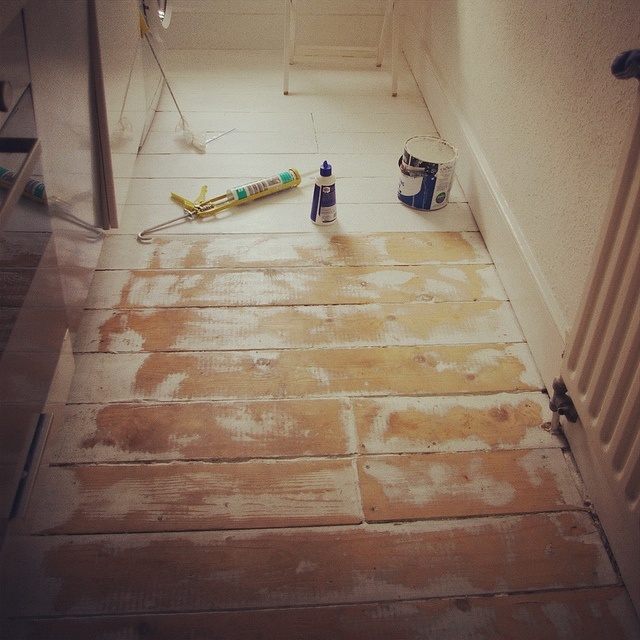Painted plywood floors can be beautiful, and depending on the type of plywood and paint you opt for, these floors can help you save quite a bit of money. Whether you’re working on an attic, a playroom for your kids, or even a den, dining room, or other living space, you’ll find that painted plywood floors are a practical, stylish choice.
How to Paint a Plywood Floor
One solid color?A pretty painted pattern? An interesting check pattern? A muted grey or bright white to open up your space? The options for painting plywood floors are nearly limitless. Before we talk colors and designs, let’s go over how to prep and paint a plywood floor for a smooth, attractive finish.
Tools and Materials Required to Paint Plywood Floors
- Patching compound and putty knife
- Wood putty
- Palm sander with 120-grit discs
- Dust mask and eye protection
- Wet/dry vacuum (shop vac)
- Mop, barely dampened
- 12-inch roller frame and corresponding roller covers
- Extension pole for the roller
- Paintbrushes in various sizes
- Oil-based wood primer, preferably labeled for floors
- Paint, such as porch and plywood floor enamel
- Pencils, stencils, masking tape, and other materials are needed to create the desired design
- Acrylic, water-based polyurethane, or shellac sealer
- Floor finish applicator for sealer
We recommend getting these tools, abrasives, and paints from popular shops like Amazon, 3M, HarborFreight, HomeDepot, AceHardware, StanleyTools, RedDevil, and Sherwin-Williams.
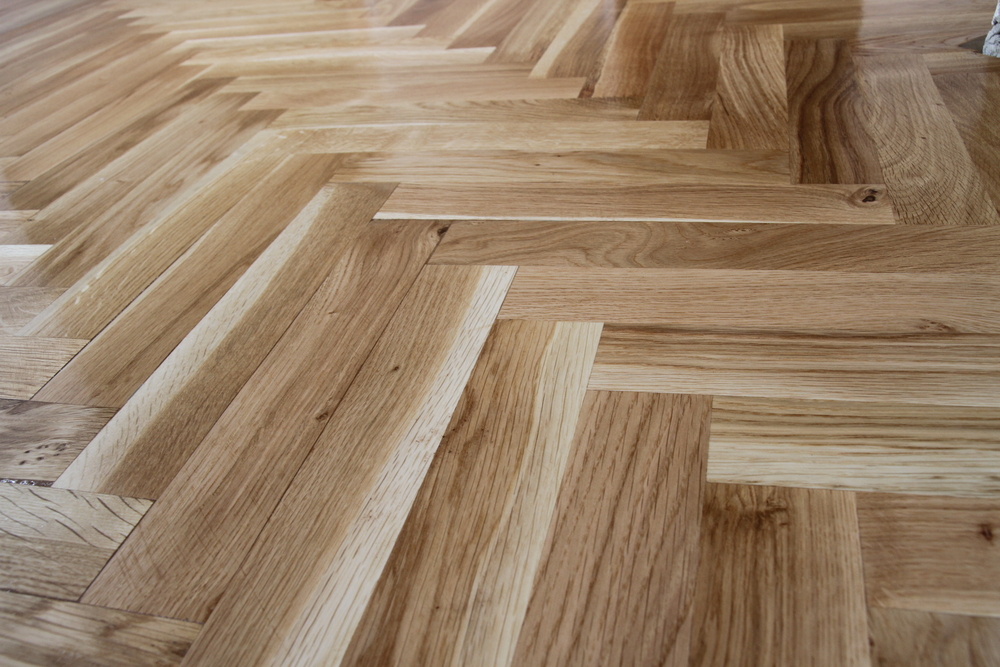
Preparing a Plywood Floor to be Painted – Step-by-Step Guide
Before you start, clear everything from the room’s floor, and be sure one corner of the floor is well-ventilated. Survey the floor to ensure that all the details of plywood are firmly attached to the floor joists beneath the subfloor, and tap down any floor fasteners protruding. You’ll be ready to start once you’ve finished this preliminary step.
1. Install painted plywood subfloors if necessary. Clean a plywood subfloor thoroughly before moving on to the next step because it is very challenging to paint a damaged plywood subfloor. Ensure all the painted plywood subfloors are in good condition, and consider replacing or fixing any pieces in bad shape.
2. Fill nail holes and joints between sheets, tack strips of plywood seams, and tack strips of plywood with wood putty or patching compound. Don’t worry too much about the neatness of nail holes; you’ll be smoothing everything when you sand.
3. Once the patching compound has dried, start sanding the concrete floor, concrete slab, and floor slab again. Work in small sections, vacuuming up the dust as you go.
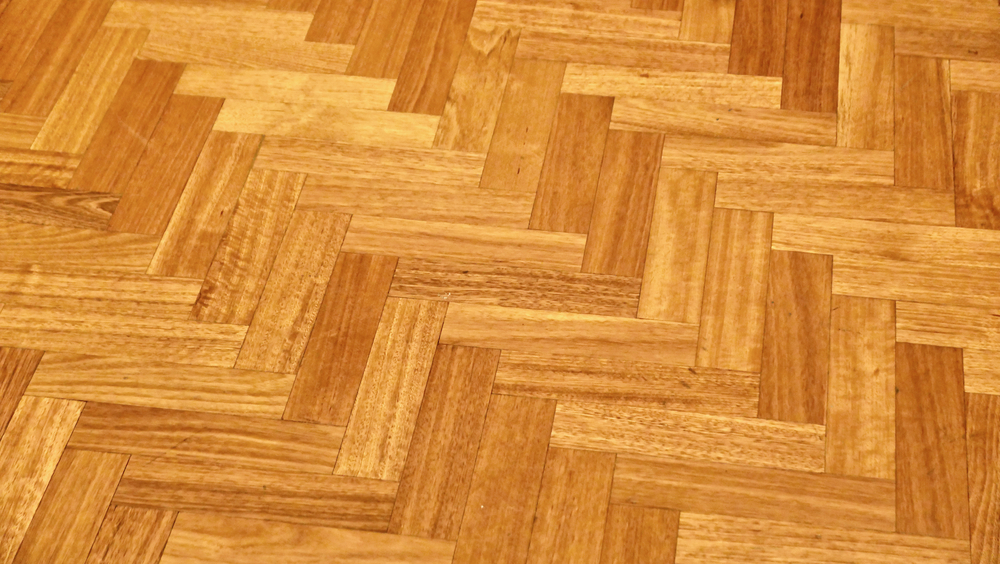
4. When satisfied with the kitchen floor’s texture, vacuum the whole thing.
5. Go over the entire kitchen floor again with a mop that has been barely dampened, removing all the carpet and the remainder of the dust. You may have to rinse the mop several times, wringing it out well after each rinse.
6. Ensure all the old carpeting and plywood floor is dust-free and completely dry before painting floors in the next step.
7. Using a paintbrush, cut in the edges chalk paint part of the floor with a primer. If you plan to apply baseboard molding when painting and the floors are finished, don’t worry about taping off.
8. Use the roller to prime the rest of the floor. Work the entire floor from wall to wall, carpeting up in sections, beginning at the section furthest from the door and working your way out. This way, you won’t be in other rooms with painted floors or corners.
9. Allow the primer to dry as per the manufacturer’s instructions. Apply a second base coat if needed.
10. Once the primer has dried completely, begin the painting process. It’s often a good idea to lay down a single coat of light-colored porch paint before stenciling a pattern. If you are working on one room with contrasting colors, lay down wet paint of the lighter color first. If working with several colors, you may be better off drawing or stenciling your pattern before laying down any paint.
11. Allow your paint to dry completely between two coats and colors. Follow the manufacturer’s instructions regarding sanding between two paint and two coats only.
12. Allow the already painted surface, floor surface, and floor to dry completely before applying the sealer. You’ll want to apply two paint coats or more for a durable finish that lasts.
13. Allow the newly painted plywood floor to dry for at least two hours before testing the new floor with bare feet to see if it’s dry. Although you can walk on it in sock-covered or bare feet, within a few hours of application, you will want to allow the finished floor to cure for 24 to 48 hours before bringing in rugs, furniture, and other items.
14. Decorate your room and enjoy!
Colors for Painted Plywood Floors
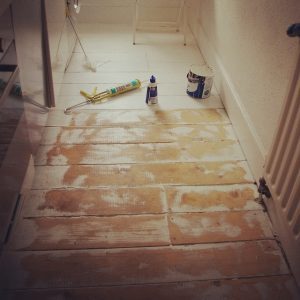
Painting the floor in white, NeroDominus
So, what about colors? Plain white or cream opens up a space, is fuss-free, and is foolproof. It’s a good choice for any space.
Other pale colors, such as the lightest hues of yellow, green, gray, or even lavender, can be nice. Be sure to consider which furnishings, rugs, and art you’ll use in your painting room.
Blue is a nice choice, too, whether brilliant and playful or subtle and muted. Be careful; the darker the color, the smaller your space will appear.
Neutral beige, tan, and coffee colors work well too. The lighter the color, the more open your room will look.
For a more vibrant appearance, try a spicy red or mustard tone. These colors work well in kitchens, studios, and other spaces where creativity reigns supreme.
Patterns to Consider for Painted Plywood Floors
If you’re considering a pattern or stencil for your painted plywood floor, you’ll find that simple checks or diamonds are easy to lay out. You can swirl the paint to get the look of stone, use an interlocking circle pattern, or stencil on another design that appeals to you.
Last but not least, remember that you’ll get the best results with high-quality plywood and painted floor, like ACX or Okoume, but you can paint any plywood floor to give your space a quick update at about an hour and the average cost of under a dollar per square foot. Price will depend largely upon the cost of the materials you choose, but you’ll find that even with high-quality plywood floors and paint, you will ultimately spend less than you would on traditional floor coverings.
Frequently Asked Questions about Painted Plywood Floors
How do you paint plywood to look like a plank of wood floor?
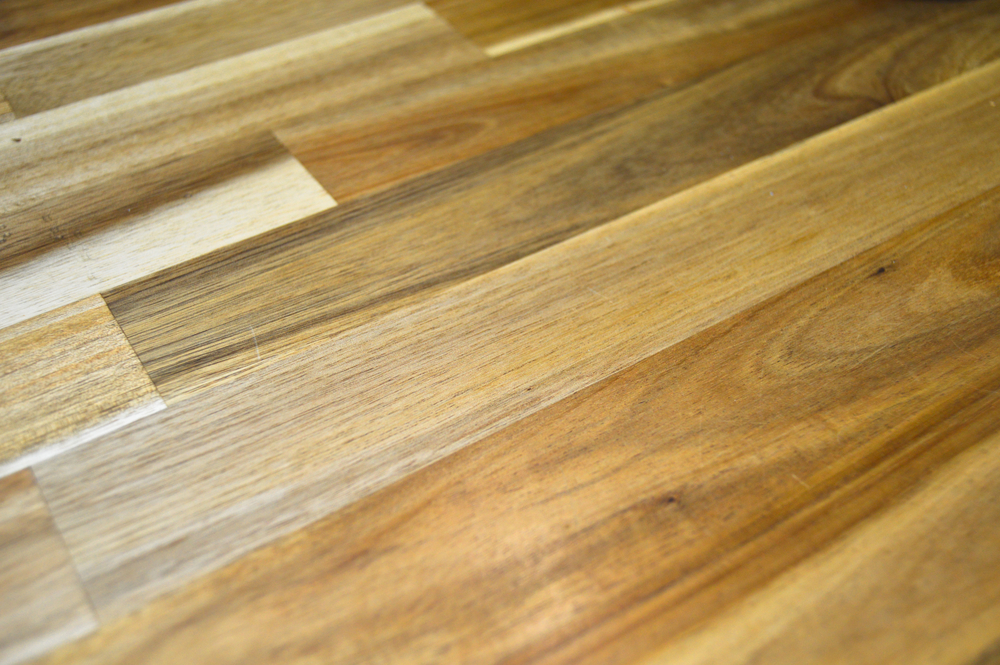
Painted plywood floor. Walnut wood can be used as background, pattern background
To paint a plywood floor to look like a plank floor, you must first prime the plywood. This can be done with a latex primer and a paint roller. Apply the primer in even strokes, working in small sections. Let the primer dry according to the manufacturer’s directions.
Once the primer is dry, you can then start painting the plywood. For best results, use a paint roller designed for rough surfaces. Apply the paint in long, even strokes. Start at the top of the plywood and work your way down. Let the paint dry according to the manufacturer’s directions before applying a second coat.
Do painted wood floors hold up?
Painted plywood floors can be quite durable if you care for them properly. Make sure to vacuum or sweep regularly to remove dirt and dust, and refinish the paint every few years to keep it looking fresh. You’ll also want to avoid excessive moisture or sunlight, which can damage the paint over time. With proper care, your painted wood floors should last for many years.
Can you mop painted plywood floors?
You can, but you need to take a few precautions:
- Ensure the paint is fully cured and the floor is sealed.
- Use a damp mop rather than a wet one.
- Avoid steam mops, as the heat and moisture can damage the floorboards.
- Be sure to dry the floor completely after mopping.
Which paint is best on plywood?
When choosing paint for plywood, acrylic latex paint is generally the best option. This paint adheres well to wood surfaces, providing good coverage and durability. Latex paint is also easy to clean up, making it a good choice for high-traffic areas. However, acrylic latex paint is not recommended for use on outdoor plywood, as it can be damaged by sunlight and moisture.
For exterior plywood projects, alkyd or oil-based paints are a better option. These paints provide better protection against the elements but can be more difficult to work with. When using any paint on plywood, apply a primer first. This will help the paint adhere better and provide a more even finish.
What do you cover plywood flooring with?
Several other flooring options are available for covering plywood floors, including hardwood flooring, laminate flooring, and vinyl flooring. Hardwood flooring is popular because it gives the plywood floors a warm and natural look. Laminate flooring is another option to give plywood floors a more finished look. Vinyl flooring is an excellent option if you want something easy to maintain and clean.
How do you make plywood look like real wood?
There are a few different ways to make plywood look like real wood. The most common method is to stain the plywood with a dark wood stain and then seal it with a clear coat of polyurethane. This will give the plywood a deep, rich color that resembles natural wood. Another option is to paint the plywood with a light-colored primer and then finish it with dark-colored paint.
This approach can create a more rustic look or be used to create a two-tone effect. Finally, you can also apply a veneer to the plywood. Veneers are thin sheets of real wood that can be glued onto the surface of the plywood. This gives the plywood an authentic wood grain that cannot be achieved with stains or paints.
Is it better to paint or stain plywood?
Paint is best for projects requiring high durability, such as shelves or cabinets. It provides a protective barrier against water and wear and can be easily cleaned with soap and water. Stain, however, is best for projects that require a natural look, such as floors or furniture. It penetrates the wood fibers to provide long-lasting protection and enhances the wood’s grain pattern.
Both paint and stain have their advantages, so it comes down to personal preference. Why not try both if you can’t decide which one to use? Paint the shelves in your kitchen for durability, and stain the wood floor throughout in living room for a warm, natural look.
What is the best finish for plywood?
When choosing a finish for your plywood subfloor or flooring, consider a few things. First, what type of plywood subfloor or floor are you using? If you’re working with hardwood plywood, you’ll want to choose a finish that protects the surface from scratches and wear. A clear lacquer or polyurethane would be a good option.
You can choose a finish highlighting the wood’s natural beauty if you’re using softwood plywood, such as pine or cedar. A stain or tinted varnish would be a good choice. Once you’ve decided on the type of finish, you’ll also need to consider how the plywood subfloor will be used. You must choose a waterproof finish if it is exposed to moisture or high humidity.
Can you make plywood flooring look like hardwood?
Yes, you can make plywood flooring look like hardwood by sealing the grain of particle board with a primer and then painting it with floor-grade enamel in the desired color. This will give you a durable surface that resembles hardwood floors.
Can you do an epoxy floor on plywood?
Epoxy flooring is a popular choice for both commercial and residential applications. It is durable, easy to clean, and slip-resistant, making it ideal for high-traffic areas. One common question is whether epoxy can be applied directly to the plywood. The answer is yes, but there are a few things to remember:
- The plywood must be in good condition with no major cracks or damage.
- It is important to rough up the surface of the plywood before applying the epoxy. This will help the epoxy to adhere better.
- Be sure to apply a primer designed for use with epoxy flooring.
How long does porch and floor paint last?
Floor paint typically lasts 3 to 5 years but can vary depending on the type of paint, the amount of traffic the floor sees, and how well it is maintained.
Floor paint is available in both water-based and oil-based formulas. Water-based formulas are more environmentally friendly.
However, water-based porch and floor paints don’t always offer the best durability or wear resistance. So if a high level of durability is required, an oil-based floor paint may be a better option.
It’s important to remember that no matter what type of porch and floor paint is used, it must be periodically resealed to maintain its appearance and protect it from moisture and other environmental damage.

